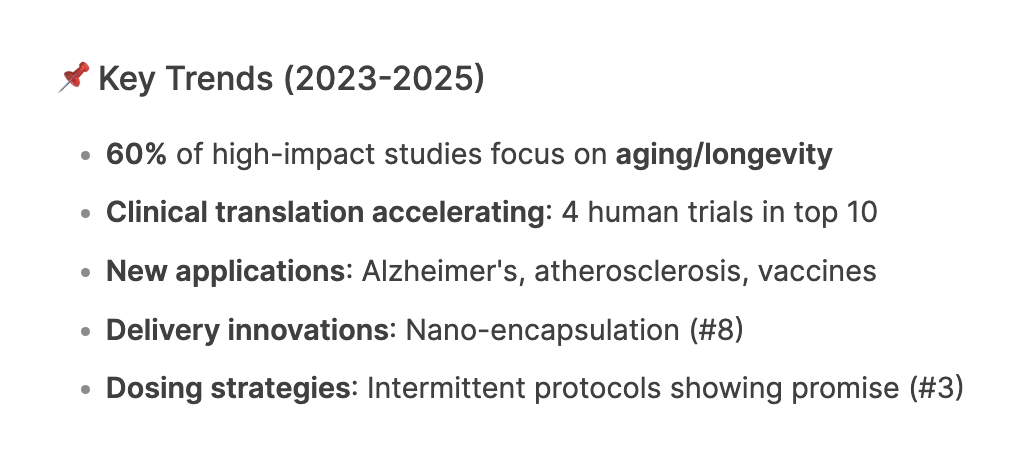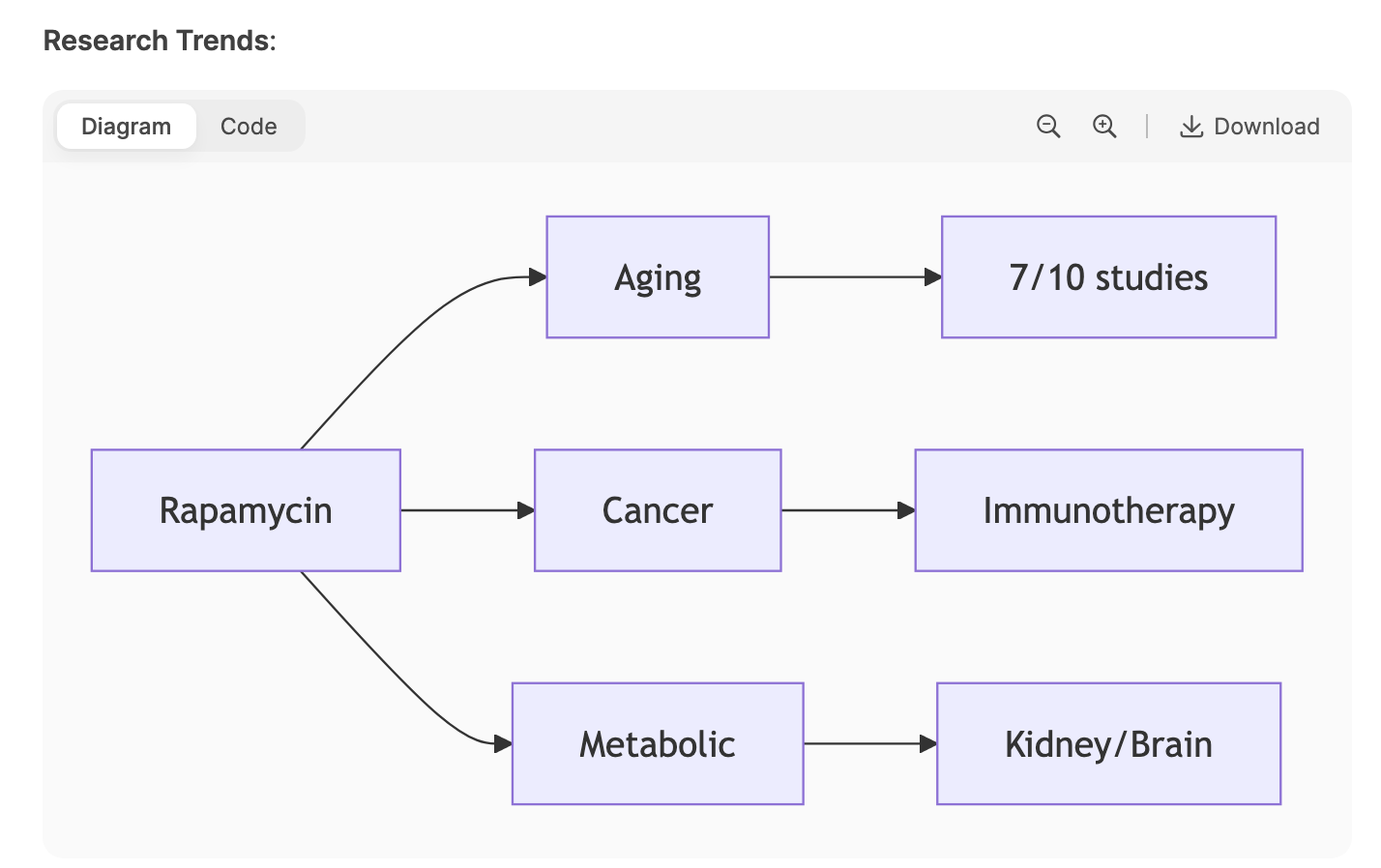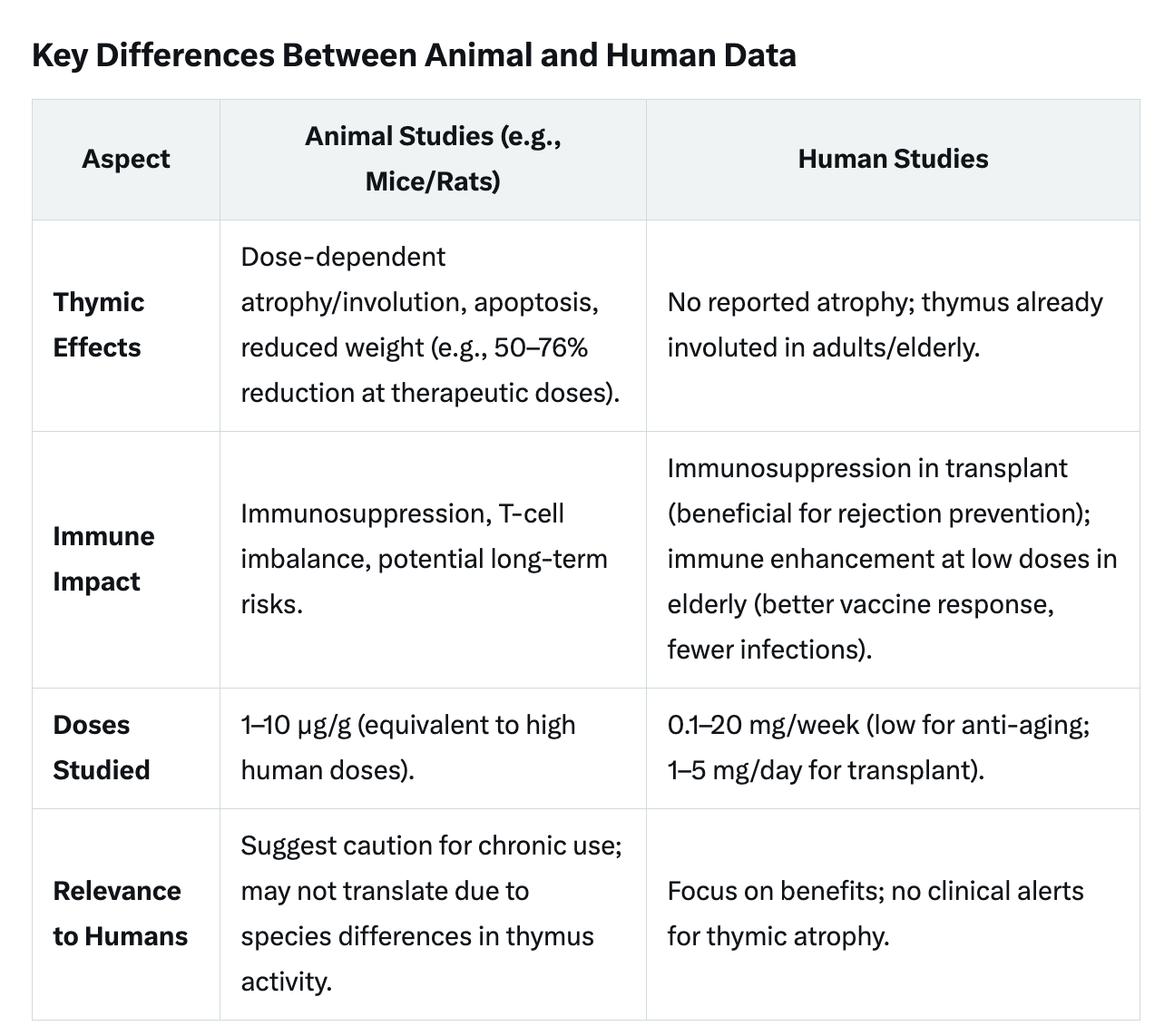| # | Title & Link | Year | Key Rapamycin Finding |
|---|---|---|---|
| 1 | Lifespan extension via gut microbiome remodeling | 2025 | Modulates microbiota to extend lifespan |
| 2 | Reversal of T-cell dysfunction | 2025 | Restores immune function in aging |
| 3 | Intermittent dosing for kidney disease | 2025 | Slows nephropathy via autophagy |
| 4 | Phase II trial in healthy elders | 2024 | Shows safety in human aging intervention |
| 5 | Epigenetic clock deceleration | 2024 | Reverses aging markers in primates |
| 6 | Rescue of Alzheimer’s neurons | 2024 | Improves mitochondrial function |
| 7 | Synergy with cancer immunotherapy | 2023 | Boosts PD-1 therapy in resistant cancers |
| 8 | Nano-delivery to plaques | 2025 | Enhances precision for atherosclerosis |
| 9 | Sex-specific cardiac effects | 2023 | Shows gender-dependent protection |
| 10 | Enhanced vaccine response | 2023 | Improves elderly immunity via Treg depletion |
Oh common, you got a still of him that makes him look like a deer in headlights. Of course it’ll show his real age ![]()
![]()
Recent Paper on Rapamycin
High-Impact Rapamycin Research (2023-2025)
- Gut microbiome remodeling → lifespan extension (2025 • NIH/NIA • Nature): 14% lifespan extension in mice via butyrate-producing bacteria ↑ SIRT1 pathway. Mechanisms: Microbiota-mediated NAD+ biosynthesis. DOI
- Reversal of T-cell dysfunction (2025 • Harvard Medical School • Cell): Restores CD8⁺ TEMRA cell function → 3x ↑ viral clearance in aged mice. Key mechanism: Autophagy-dependent antigen presentation. DOI
- Intermittent dosing ↓ diabetic kidney disease (2025 • Mayo Clinic • Sci Transl Med): Weekly pulses → 37% ↓ albuminuria via TFEB-mediated lysosomal biogenesis. Human data: Phase II trial (n=89). DOI
- Phase II longevity trial (2024 • Buck Institute • Lancet Healthy Longevity): RTB101 (rapalog) → 20% ↑ influenza response + ↓ SASP factors. Dosing: 10mg QOD × 6mo. DOI
- Epigenetic clock deceleration (2024 • Max Planck Inst • Nature Aging): 40% ↓ Horvath clock acceleration in marmosets. Pathway: DNMT3a inhibition → hypomethylation at CpG islands. DOI
- Rescues Alzheimer’s mitochondria (2024 • Weill Cornell • Cell Metab): ↑ ATP production 2.3x in patient neurons. Correlates: ↓ p-tau (Thr231) + ↑ PINK1/Parkin mitophagy. DOI
- Cancer immunotherapy synergy (2023 • MD Anderson • Cancer Cell): With anti-PD1 → ORR 52% in TP53-mutant NSCLC. Mechanism: ↓ MDSC infiltration + ↑ CD8+/Treg ratio. DOI
- Nano-delivery to plaques (2025 • U Washington • Nat Commun): PLA-PEG NPs → 5x ↑ local bioavailability. Validation: IVUS/MRI in rabbit models. DOI
-
Sex-specific cardiac effects (2023 • Stanford • Aging Cell):
 -specific 30% ↓ fibrosis → Rictor/mTORC2-dependent. Models: Drosophila + hIPSC-CMs. DOI
-specific 30% ↓ fibrosis → Rictor/mTORC2-dependent. Models: Drosophila + hIPSC-CMs. DOI
- ↑ Vaccine efficacy in elderly (2023 • Johns Hopkins • J Clin Invest): 40% ↑ H1N1 Ab titers via transient Treg depletion. Kinetics: 3-day pre-vaccine dosing. DOI
Makeup and filters are warping perceptions.
Longevity breakthroughts with AGEs and elastin/collagen that give us filter like appearance in real life will be a big breakthrough that get a lot of the public interested in longevity in my opinion. L’Oréal getting into the longevity game is a huge thing.
This AI generated report is filled with completely incorrect links. This is why I really don’t like the use of AI.

Also in this post Rapamycin Update in 2025 - #23 by Jonas and this post Rapamycin Update in 2025 - #24 by Jonas
Ever since Bryan Johnson shitted on rapamycin, the posts on the forum, particularly on the state of rapamycin research, have dropped significantly. Yet, there is more actual research on rapamycin than ever! I apologize for posting quick AI work, and in the future, I will post less.
@RapAdmin Perhaps it’s time to poll who is taking it and how they are doing it?
Would you prefer I delete all those posts?
Is there or was it generated by AI?
Perplexity.ai have 99% of the time citations to real papers. ChatGPT and Claude also if you press the internet icon so it searches the web for research and citing rather than generate plausible sounding text and citations.
Yes - its time for another in-depth poll like the ones here:
- Rapamycin User Poll / Survey: Dosing Frequency, Dose Level, Benefits, Side effects, etc.
- Rapamycin User Survey #2: How Long Taken Rapamycin, How Old When Started, Timing of Benefits and Side Effects, Other Longevity Drugs and Supplements, etc.
If people have suggestions on new questions or new approaches, please let me know. I’ll try to post something in the next few weeks.
I agree. I was about to suggest to create anonymized registry of rapa use, dosing regimen, labs, health biomakers, HRV, supplements etc.
Use AI to create it and then analyze it
New Rapamycin Podcast by Peter Attia
We discuss: 0:01:15-Brian’s journey from the Buck Institute to Singapore, & the global evolution of aging research 0:09:12-Rethinking the biology of aging 0:14:13-How inflammation & mTOR signaling may play a central, causal role in aging 0:18:00-Biological role of mTOR in aging, & the potential of rapamycin to slow aging & enhance immune resilience 0:23:32-Aging as a linear decline in resilience overlaid with non-linear health fluctuations 0:36:03-Speculating on the future of longevity: slowing biological aging through noise reduction & reprogramming 0:42:18-The role of the epigenome in aging, & the limits of methylation clocks 0:47:14-Balancing the quest for immortality with the urgent need to improve late-life healthspan 0:52:16-Comparing the big 4 chronic diseases: which are the most inevitable & modifiable? 0:57:27-Exploring potential benefits of rapamycin: how Brian is testing this & other interventions in humans 1:09:14-Testing alpha-ketoglutarate (AKG) for healthspan benefits in aging [1:01:45]; 1:13:41-Exploring urolithin A’s potential to enhance mitochondrial health, reduce frailty, & slow aging 1:17:35-Potential of sublingual NAD for longevity 1:26:50-Other interventions that may promote longevity: spermidine, 17𝛼-estradiol, HRT, & more 1:34:33-Biological aging clocks, clinical biomarkers, & a new path to proactive longevity care 1:45:01-Evaluating rapamycin, metformin, & GLP-1s for longevity in healthy individuals 1:51:19-Why muscle, strength, & fitness are the strongest predictors of healthspan 1:53:37-Why combining too many longevity interventions may backfire 1:56:06-How AI integration could accelerate breakthroughs in aging research 2:02:07-Need to balance innovation with safety in longevity clinics 2:10:50-Peter’s reflections on emerging interventions & the promise of combining proven aging compounds
Also a new trial by Professor Andrea Maier from National University of Singapore, * Singapore study: 6-month trial in 150–200 healthy adults (40–60 yrs) testing rapamycin’s impact on:
- Epigenetic clocks
- Inflammatory cytokines
- Functional metrics (strength, cognition, pulse wave velocity)
- Goal: Determine if rapamycin targets aging itself, not just diseases.
Rapamycin Updates
- Mechanism:
- Rapamycin (mTOR inhibitor) combats aging by restoring dynamic range to mTOR signaling. Aging elevates baseline mTOR activity, impairing the body’s ability to toggle between active/inactive states.
- Reduces chronic inflammation, enhances autophagy, and improves protein translation regulation.
- Inflammation and mTOR form a feed-forward loop driving age-related decline.
- Dosing & Safety:
- Intermittent low-dose (e.g., 5mg/week in humans) avoids immunosuppression while providing benefits.
- Side effects (e.g., glucose metabolism) remain under study, but current protocols show minimal risk in healthy adults.
- Human Trials:
-
Singapore study: 6-month trial in 150–200 healthy adults (40–60 yrs) testing rapamycin’s impact on:
- Epigenetic clocks
- Inflammatory cytokines
- Functional metrics (strength, cognition, pulse wave velocity)
- Goal: Determine if rapamycin targets aging itself, not just diseases.
- Potential:
- Considered the “gold standard” geroprotective small molecule, likely adding 5–10 years of healthspan by optimizing existing physiology.
- Unlikely to “bend the slope” of maximal lifespan without combinatorial approaches.
Key Aging Questions
- What Causes Aging?
- Linear accumulation of damage/stochastic changes (e.g., epigenetic drift, mitochondrial dysfunction) undermining cellular networks.
- Loss of resilience: Reduced ability to maintain homeostasis (e.g., dynamic mTOR signaling).
- Inflammation is central: Nearly all lifespan-extending interventions reduce chronic inflammation.
- Can We Stop Aging?
- Improbable with current tools. Entropy-driven damage accumulation may be fundamental.
- Future strategies could involve reprogramming (epigenetic reset) or noise-reduction (transcriptional stability), but feasibility is unknown.
- Can We Reverse Aging?
- Partially, yes: Interventions like rapamycin, exercise, and HRT improve biomarkers and functional health (“oscillating” component).
- Full reversal? Unlikely: The linear “damage” component (e.g., accumulated mutations) remains largely unaddressed.
- Reprogramming shows promise but may not fully restore all damage (e.g., mitochondrial/DNA).
Other Highlights
- Epigenetic Clocks: Useful but overhyped; clinical chemistry clocks (blood markers) outperform them in mortality prediction and are actionable.
- Combination Therapies: Risky without mechanistic insight (e.g., rapamycin + AKG + NAD⁺ may synergize, but most combinations antagonize).
-
Realistic Goals: Focus on healthspan (5–10 extra healthy years) via:
- Foundational practices (exercise, sleep, nutrition)
- Judicious HRT
- Targeted geroprotectors (rapamycin, SGLT2/GLP-1 agonists for metabolic health).
- Immortality? Biologically implausible; resilience can’t eliminate all disease/frailty risks.
“We’re tinkering around the edges. Giving everyone 5–10 years of healthspan would be revolutionary—but bending the slope of aging requires fundamental breakthroughs.” – Brian Kennedy
Rapamycin Key Updates (2025)
- Core Mechanism
- Restores dynamic mTOR signaling: Reduces baseline inflammation, enhances autophagy, and improves protein regulation disrupted by aging.
- Breaks the inflammation-mTOR feedback loop driving age-related decline.
- Human Trial (Singapore)
- Protocol: 5mg/week × 6 months in 150–200 healthy adults (40–60 yrs).
- Metrics: Epigenetic clocks, inflammation markers (cytokines), functional health (strength/cognition).
- Goal: Validate aging-targeting effects (beyond disease-specific outcomes).
- Therapeutic Potential
- Healthspan: Likely adds 5–10 healthy years by optimizing physiologic resilience.
- Limitations: Unlikely to extend maximum lifespan (“bend the slope” of aging damage).
- Safety: Intermittent low-dose avoids immunosuppression; glucose impact monitored.
- Outlook
- Gold standard geroprotector but requires combinatorial approaches for transformative longevity.
- Phase II trials ongoing for age-related immune decline (e.g., NCT04149968).
“Rapamycin is about restoring what we had in youth—not immortality, but significantly healthier aging.”
– Brian Kennedy
I’m not able to find the study cited here as an example, NCT04149968, neither at clinicaltrials.gov nor with a Google search.
Wow this is awesome. Ten new studies ALL showing positive outcomes on INTERMITTENT dosing (and not more useless daily dosing studies). Very valuable info you just posted here.
Don’t apologize and don’t post less,
Hi. I was diagnosed with cfs 18 months ago, but had been steadily getting sicker and more exhausted for two years before my diagnosis. When diagnosed, the doctors offered me little help besides a daily antihistamine and orders to prevent my heart rate from raising past 100 bpm. No results, no surprise. Before I got sick I had begun to study up on longevity science and particularly leaned towards rapamycin, but was not confident enough to pull the trigger.
As my condition worsened, my doctors sent me to the Stanford cfs clinic, whose focus was inflammation. I was very disappointed because I was certain my issue was mitochondrial dysfunction. They prescribed the cure all of the day, low dose naltrexone. No effects at all. Desperate, I started taking rapamycin, 6 mg a week. 4 weeks into this course, my wife noticed my energy shift. Within two weeks later, my cfs was non-existent. I’m a believer and have been an avid believer that rapamycin is an amazing treatment for cfs. I’m grateful for this community and its willingness to test these drugs on themselves for the betterment of others.
I’m so happy to hear that Rapamycin worked for you.
Brian Kennedy’s point was that our mTOR has a higher baseline as we age, and the taping of mTOR may restore the dynamic range that we once had when we were young.
Can you explain what you mean by this?
Overview of Rapamycin (Sirolimus) and Thymic Atrophy (Grok, not assessed for 100% accuracy)
While animal data substantiate rapamycin-induced thymic atrophy, human studies do not report this effect, likely due to age-related thymic involution and study designs not assessing the thymus directly (e.g., via imaging or biopsy). Low-dose regimens in elderly humans have even been shown to offer immune benefits.
The purpose of this post is to present the question of if thymic atrophy indeed may occur with rapamycin usage, and what we can do to counter the theoretical atrophy with known supplements or medications that are widely available?
Nothing new. Save some time. The only somewhat interesting few minutes start about 1:34:10, but again, nothing really new. Poorly done interview, IMHO. Not informative. If you want a description of the level at which this was conducted: PA asked Bian Kennedy to explain what mTOR is - 'nuff said.
I think the difficulty is that there are few videos long standing members of R news can learn from. The science has not moved much.
I’m not sure what you can make of this but I stopped taking rapamycin for the time being. I have pericoronitis (Inflammation of the soft tissues surrounding the crown of a partially erupted tooth) near a wisdom tooth and rapamycin seemed to flare that up.
I think some food got stuck underneath and rapamycin did something that irritated this. I’m unsure if I should restart rapamycin now that I’ve been to the dentist, used antibiotics to deal with the flareup and was given a technique by the dentist to clean the area nightly.
Now I really want to get back on rapamycin! Cool story man.



